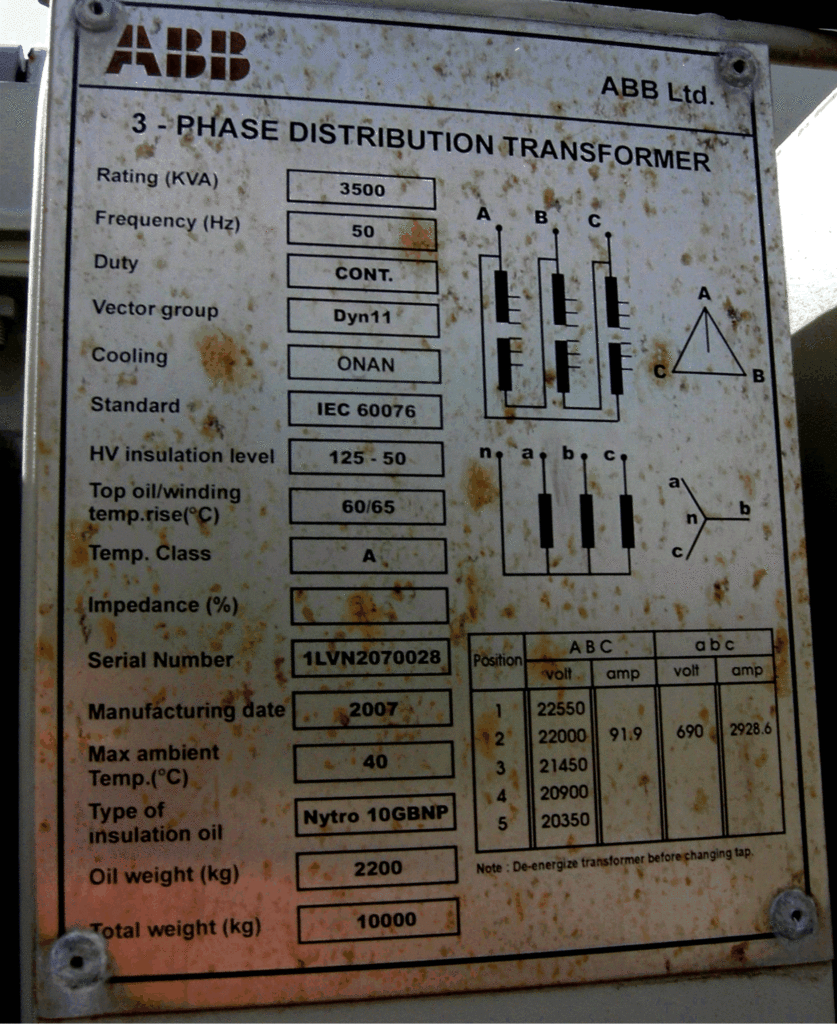The article provides guidance on interpreting transformer nameplates, detailing essential information such as kVA rating, voltage ratings, frequency, temperature rise, insulation class, and percentage impedance. It outlines common conventions for specifying transformer voltage ratings and highlights key details typically found on nameplates, including serial number, frequency, temperature rise, and connection diagram.
How To Read A Transformer Nameplate
Transformer nameplates contain several standard items of information and other optional information. The transformer nameplate must specify the following parameters:
- Volt-Ampere (VA) or kilovolt-amperes (kVA) rating
- The voltage rating of both the primary and secondary circuits
- The impedance rating of the transformer (normally restricted to 25 kVA or larger)
- The required clearances for transformers with ventilated openings
- The amount and kind of insulating liquid where used.
- On dry-type transformers (no liquid coolant or insulation), the nameplate listing must also include the class temperature rating of the winding insulation.
Figure 1: Transformer Nameplate Details
Transformer kVA Rating
The nameplate always indicates the size of the transformer in terms of how much apparent power (rated kVA) it is designed to deliver to the load on a continuous basis. By its very nature, the transformer will have more than one rated voltage, depending on which side we are looking at and how many windings there are on that side.
Transformer Voltage Ratings
The following is a list of some conventions for specifying transformer voltage ratings:
U-W
The dash between the voltages U and W indicates they are on different sides of the transformer. For example, 480—120 tells us the primary winding is rated 480 V, and the secondary is rated 120 V.
U/W
The slash indicates the two voltages are from the same winding and that both voltages are available;
- g., 120/240 can indicate a 240-volt winding with a center tap.
U×W
The cross indicates a two-part winding that can be connected in series or parallel to give higher voltage or current respectively. Only one voltage is available at a time; e.g., 120×40 indicates the transformer can operate at 120 V or 240 V, but not both simultaneously.
U Y/W
The Y indicates a three-phase winding connected in a wye configuration. The first letter (U) is the line voltage, and the second letter (W) is the phase voltage (line to neutral). Clearly, U=√3 W. Examples include 208Y/ 120 and 480Y/277.
Transformer Rated Frequency
The rated frequency will also be indicated on the nameplate (usually 60 Hz for the United States). Operating the transformer at a lower frequency will increase the core flux unless the voltage is reduced; this could cause magnetic saturation of the core and overheating due to increased hysteresis and eddy current losses.
Maximum Temperature Rise
The maximum allowable temperature rise for the transformer is also shown on the nameplate and is based on an assumed ambient temperature of 30oC.
Insulation Class
The insulation class indicates the type of transformer insulation.
Transformer Percentage Impedance
Percent impedance is a representation of the impedance of the windings referred to on one side of the transformer. This number is the percentage of rated voltage that must be applied to the high side to cause rated current on the low side when the low side is shorted.
Other items that may be on the nameplate include the number of phases, a Wiring diagram, and tap-changing information.
Transformer Nameplate Information
Following is the key information which is provided on the transformer nameplate from the manufacturer.
| Serial number | Number of phases |
| Frequency | Voltage rating |
| kVA Rating | Temperature Rise |
| Polarity | Percentage Impedance |
| Connection Diagram | Name of Manufacturer |
| Type of insulating liquid | Conductor Material for each Winding |
| Basic Insulation Level (BIL) | Total Weight (kg) |
